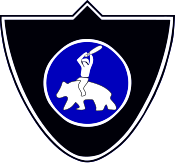
Back الحركة الشعبية الوطنية Arabic Moviment Patriòtic Popular Catalan Vaterländische Volksbewegung German Patriota Popola Movado Esperanto Movimiento Patriótico Popular Spanish Isänmaallinen kansanliike Finnish Mouvement patriotique (Finlande) French Movimento Patriottico Popolare Italian 愛国者国民運動 Japanese 애국인민운동 Korean
Patriotic People's Movement Isänmaallinen kansanliike | |
|---|---|
 | |
| Abbreviation | IKL |
| Founders | Erkki Räikkönen[1]
... and others |
| Founded | 5 June 1932 |
| Dissolved | 23 September 1944 |
| Preceded by | Lapua Movement |
| Succeeded by | IKL (1993)[a] |
| Headquarters | Mikonkatu 15, Helsinki |
| Newspaper | Ajan Suunta |
| Youth wing |
|
| Trade union | National Trade Union Confederation of Finland[3] |
| Membership | 100,000 (1930’s est.)[4] |
| Ideology | Greater Finland Finnish nationalism[5] Clerical fascism Corporate statism[6] |
| Political position | Far-right[7] |
| Religion | Lutheranism |
| Colours | Black White Blue |
| Anthem | "Luo Lippujen"[8] (lit. 'Rally to the flags!') |
| Most MPs in the Parliament (1936) | 14 / 200 |
Patriotic People's Movement (Finnish: Isänmaallinen kansanliike, IKL, Swedish: Fosterländska folkrörelsen) was a Finnish nationalist and anti-communist political party. IKL was the successor of the previously banned Lapua Movement. It existed from 1932 to 1944 and had an ideology similar to its predecessor, except that IKL participated in elections with limited success.
- ^ Philip Rees, Biographical Dictionary of the Extreme Right Since 1890, Simon & Schuster, 1990, p. 312
- ^ a b Mikko Uola: Sinimusta veljeskunta – Isänmaallinen kansanliike 1932–1944. Otava, 1982. ISBN 951-1-06982-9., osa VIII: Sinimustat ja mustapaidat, pages 292–313
- ^
- Kalle Seppä : Taantumus! Radikaali oikeistolainen traditio (Megafoni.org)
- Jussi Maijala : Kansankokonaisuuden puolesta : IKL – ei luokkia tai yksilöitä vaan kansankokonaisuus, teoksessa Petri Juuti (toim) : Sinistä, punaista, mustaa - Näkökulmia Suomen 1930–40-lukujen poliittiseen historiaan. Tampereen yliopistopaino, Tampere 2005 ss. 68–69
- ^ Vares, Vesa and Uola, Mikko & Majander, Mikko (2006) Kansanvalta koetuksella [Democracy under test]. Series: The Finnish Parliament: 100 Years, Part 3. Helsinki: Edita. pp.248,253. ISBN 9513745430
- ^ Nissen, Henrik (1983). Scandinavia during the Second World War. Universitetsforlaget. p. 25.
The fascist-inspired, ultranationalist IKL (the Patriotic People's Movement)
- ^
Badie, Bertrand; Berg-Schlosser, Dirk; Morlino, Leonardo, eds. (7 September 2011). International Encyclopedia of Political Science. SAGE Publications (published 2011). ISBN 9781483305394. Retrieved 9 September 2020.
[...] fascist Italy [...] developed a state structure known as the corporate state with the ruling party acting as a mediator between 'corporations' making up the body of the nation. Similar designs were quite popular elsewhere in the 1930s. The most prominent examples were Estado Novo in Portugal (1932-1968) and Brazil (1937-1945), the Austrian Standestaat (1933-1938), and authoritarian experiments in Estonia, Romania, and some other countries of East and East-Central Europe,
- ^ "Suomen tilastollinen vuosikirja 2004" (PDF). Retrieved 27 March 2021.
- ^ "15.7.1936 Lakeus no 157, s. 1". digi.kansalliskirjasto.fi.